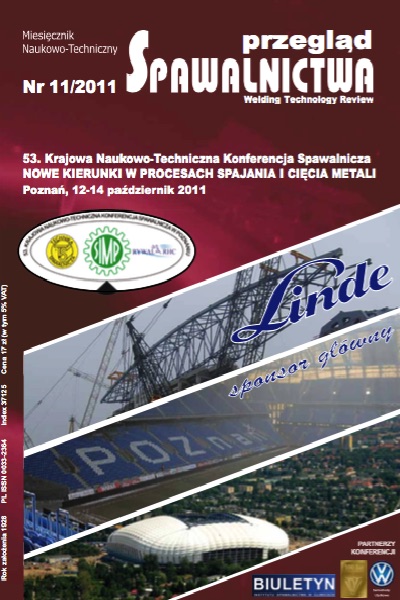Neuartiges konzept zur schweißparameterregelung beim widerstandspunktschweißen
Main Article Content
Abstract
The analysis of influence of the gap between the joining steel plates of varying strength in the conven- tional spot welding and spot welding with weld and heat-affected zone geometry control on the welds quality is presented. It is shown that the new spot welding process with the weld and heat affected zone geometry control system is particularly advantageous for high strength steel joining, especially for thick plates.
Nowoczesna koncepcja regulacji parametrów zgrzewania oporowego punktowego
Przeprowadzono analizę wpływu szczeliny między łączonymi blachami ze stali o różnej wytrzymałości w procesie punktowego zgrzewania konwencjonalnego i zgrzewania z zastosowaniem sterowania geometrią zgrzeiny i strefy wpływu ciepła na jakość złączy. Wykazano, że nowy proces zgrzewania punktowego z systemem regulacji geometrii zgrzeiny i strefy wpływu ciepła jest szczególnie korzystny w przypadku łączenia stali o wysokiej wytrzymałości, zwłaszcza przy większej grubości blach.
Downloads
Article Details
Creative Commons CC BY 4.0 https://creativecommons.org/licenses/by/4.0/
Welding Technology Review (WTR) articles are published open access under a CC BY licence (Creative Commons Attribution 4.0 International licence). The CC BY licence is the most open licence available and considered the industry 'gold standard' for open access; it is also preferred by many funders. This licence allows readers to copy and redistribute the material in any medium or format, and to alter, transform, or build upon the material, including for commercial use, providing the original author is credited.
References
Jüttner S., Meyer R.: leichtbau Herausforderungen für die Fügetechnik. Volkswagen AG, Aktionstag Innovation im Automobilbau, Dresden, 2007.
Müller S.: Fügetechnologien im Karosseriebau Status und Trends. Konferenz: Automobilbau Trends in der Fügeund Werkstofftechnik, 2008.
Bergmann J.P.: Łączenie stali ocynkowanej: stan aktualny i perspektywy. Przegląd Spawalnictwa, 8-9/2004, s. 76.
Füssel U., Jüttner S., Meyer R.: Wirkung von Toleranzen im
Karosseriebau auf die Fügetechnik. Zwischensitzung IIW SC
Automotive and Road Transport; Berlin am 19-20.03.2008
Baryliszyn P., Noack Th., Füssel U., u.a.: Erweiterung der Schweißzangenregelung auf Basis der Elektrodenreferenzkraft. 21. DVS-Sondertagung, Widerstandspunktschweißen
, Duisburg, 2010.
Baryliszyn P., Jüttner S., Füssel U.: Neuartiges Regelsystem
zum Widerstandspunktschweißen von Karosseriebauteilen mit Maßabweichungen. Große Schweißtechnische Tagung, 15. September 2009.
Tl4225: legierter Vergütungsstahl 22MnB5, ungeschichtet oder vorbeschichtet; Werkstoffanforderungen an Halbzeuge und Bauteile. Stand 2006.
PN-EN 10025: Wyroby walcowane na gorąco ze stali kon- strukcyjnych. Stand 2007.
Woestmann H.: Moderne Stahlfeinbleche für den Automobilleichtbau. Aktueller Stand und Ausblick in die Zukunft. Erfahrungsaustauschgruppe PZS-Werkzeuge, lüdenscheid, 2005.
Overrath J.: Schweißen von warmumgeformten Bauteilen. 11. ifs Kolloquium, Braunschweig, 2007.
PV 6702: Punktschweißverbindungen. Festigkeitsprüfung Stahlwerkstoffe. Stand 2004.
DVS-RichtlinieDVS 2902-3: Widerstandspunktschweißen von Stählen bis 3 mm Einzelblechdicke. Konstruktion und Berechnung. Stand 1991.
Piwowar S.: Spawanie i zgrzewanie elektryczne. WSiP, Warszawa, 1966.
ISO 6520-2: Welding and allied processes: Classification of geometric imperfections in metallic materials. Part 2: Welding with pressure. Stand 2001.
VW 01105-1: Widerstandspunktschweißen. Konstruktion, Berechnung. Stand 2007.
